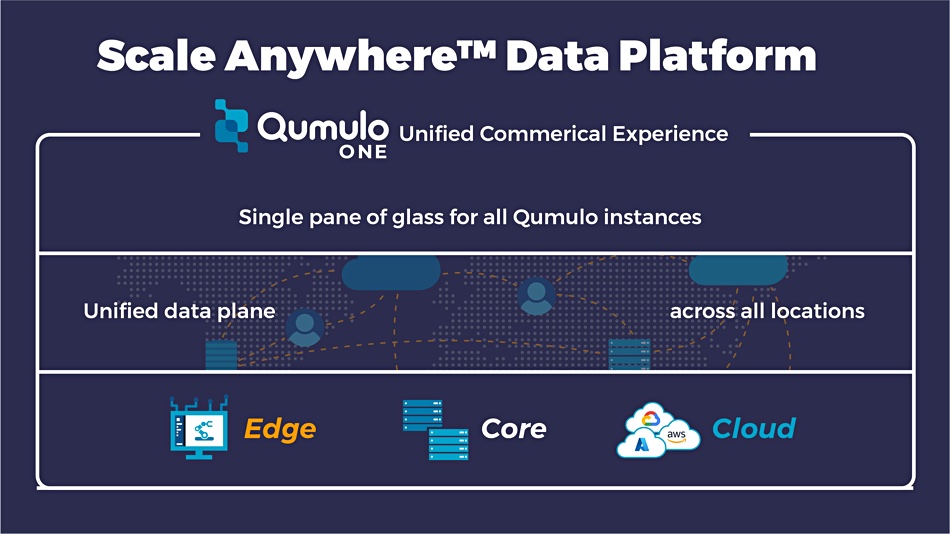Qumulo has added a native Azure implementation of its scale-out file system, complementing its existing edge, on-premises, and public cloud presence.
Its Scale Anywhere concept matches NetApp’s data fabric vision in scope and arguably provides a more scalable and parallel filesystem than NetApp’s ONTAP in the public clouds and Dell’s APEX File Storage for AWS.
Qumulo CEO Bill Richer said: “Unstructured data is everywhere in the enterprise and growing at an unprecedented rate, a reality that traditional storage solutions have constantly grappled with. Qumulo finally fixes this with a software platform built for hybrid IT that scales to exabytes anywhere unstructured data is generated, stored, consumed, or managed.”
The Scale Anywhere vision in a nutshell is up to exabyte-level file storage on-premises, edge, datacenters, and the public cloud. It’s a vision shared and pioneered by NetApp, Dell, and HPE (GreenLake).

Kiran Bhageshpur, Qumulo CTO, said in a briefing: “I look at this as the third era of data. First, there was the NetApp era, which was scale-up domain controllers connected across SAS expanders. They owned the 1990s and the early 2000s. Then there was a scale-out era, which was very much Isilon’s kind of game, and I was there. We really ran the table at that point in time, and it’s the 8,000-pound gorilla for large scale unstructured data today. I believe we are in the third era, which is scale anywhere.

“What’s changed from 15 years ago to now is the fact that data is everywhere. It’s not just datacenters, it is the edge. And the edge is very dispersed. We’ve got customers who are talking about hundreds of terabytes and mining sites, you’ve got national defense workflows with forward operating bases and geosynchronous or other satellite imagery and longtime drone imagery, which needs to be shared all across the edge. And then of course you’ve got the cloud with an absolute plethora of services.”
A file system and data services supplier has to cover all these bases. Bhageshpur told us “file in the cloud has been a joke” because it doesn’t use a cloud-native approach. That was true of the initial April Azure Qumulo implementation. “The version we put out in April was still what I would call a version 1.0 from a cloud architecture point of view as it was a lift and shift … What we are now announcing is a truly cloud-native Enterprise File System in the cloud, starting with Azure.”
Qumulo says the Scale Anywhere Platform has four components:
- Ability to run on commodity hardware or in the (main) public clouds.
- A Nexus unified control plane for customers to manage all their Qumulo instances anywhere.
- Q-GNS global namespace providing a unified edge-to-datacenter-to-public cloud data plane with its data services – multi-protocol access, enterprise security integrations, snapshots, quotas, replications etc. – delivered within this geographically distributed namespace. Qumulo says customers can access remote data as if it were local for all their workflows, from the most performance-sensitive applications to active archives.
- Azure Native Qumulo (ANQ), described by Qumulo as “the first cloud-native enterprise file system with unlimited exabyte scale, unmatched economics, and performance elasticity.”
Note that the current Qumulo implementations on AWS (Qumulo File Data Platform) and GCP are not included in this component list. They are not cloud-native. We expect that cloud-native versions will arrive in due course. Bhageshpur said: “Our view is scale anywhere. So every single cloud, every single hardware platform.”
ANQ was developed with Microsoft and data is stored in Azure Blob object storage buckets with caching to speed up access. Bhageshpur said: “The caching uses Azure ephemeral instances’ attached NVMe as a read cache, we also use a high performance managed disk as a protected cache.” Qumulo says 99 percent of ANQ I/O operations are served from the cache, improving performance and shielding file workloads from cloud object storage latencies.
- ANQ separates performance from long-term storage retention, allowing each layer to scale independently, elastically, and seamlessly. It lets customers dynamically raise and lower their cluster’s throughput rates on demand, as needed.
- ANQ leverages Azure’s 12 nines of data durability and its clustered architecture so files are dependably available.
- ANQ is almost 80 percent less expensive than the closest alternative (understood to be Azure NetApp Files), and is comparable to the fully burdened on-premises cost of file storage.
- ANQ data services include quotas, snapshots, multi-protocol access, enterprise security integrations, and real-time data analytics.
- ANQ can be configured and deployed directly from the Azure service portal in minutes.
Bhagesphur said of cost: “For the first time file in the cloud, rich enterprise file in the cloud is going to be comparable to the cost of object in the cloud.”
ANQ has a cloud-familiar pay-as-you-go model in its pricing structure, where economics improve as data volume grows.
Monthly pay-as-you-go pricing is $30 per TB per month (for 1 PB and beyond). Pricing starts at $37 per TB per month (baseline commitment of 100TB), with an incremental charge per TB as data grows.
Microsoft’s Maneesh Sah, CVP Azure Storage, said: “Combining Microsoft Azure Blob Storage with Azure Native Qumulo, Microsoft and Qumulo deliver familiar on-premises file management capabilities at costs similar to object storage. Azure is the only cloud that offers the balance of performance, cost, and scalability.”
Qumulo is also announcing a consumption-based Qumulo One pricing model.
Bhageshpur said: “With our latest update to Azure Native Qumulo, customers can migrate their file-based AI/ML workloads to the cloud, and run them natively in Azure at scale, without compromising performance, features, or cost.” He also said that Qumulo Scale Anywhere customers won’t need Hammerspace to orchestrate files within the Qumulo namespace as Qumulo includes that kind of functionality.
He thinks Qumulo operates at a level of scale beyond the capabilities of edge-caching cloud-based file data services suppliers such as CTERA, Nasuni, and Panzura, characterized as home directory-style use cases: “My view is that a lot of what Panzura, especially Nasuni, are doing … is going to get subsumed by some variation of OneDrive, Google Drive, or Dropbox … Whereas what we are looking at is hundreds of terabytes to hundreds of petabytes, really large scale data.”
The Q-GNS global namespace hits private preview from November 9 then public preview on February 1. ANQ is generally available.








